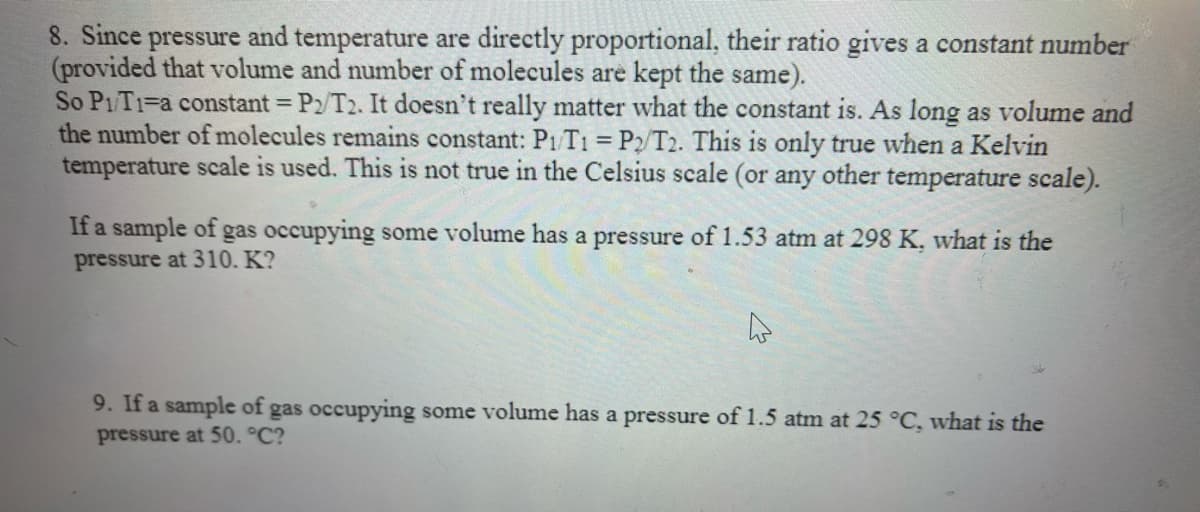8. Since pressure and temperature are directly proportional, their ratio gives a constant number (provided that volume and number of molecules are kept the same). So P1T1=a constant = P2/T2. It doesn't really matter what the constant is. As long as volume and the number of molecules remains constant: P1/T1 = P2/T2. This is only true when a Kelvin temperature scale is used. This is not true in the Celsius scale (or any other temperature scale). %3D If a sample of gas occupying some volume has a pressure of 1.53 atm at 298 K, what is the pressure at 310. K? 9. If a sample of gas occupying some volume has a pressure of 1.5 atm at 25 °C, what is the pressure at 50. °C?
8. Since pressure and temperature are directly proportional, their ratio gives a constant number (provided that volume and number of molecules are kept the same). So P1T1=a constant = P2/T2. It doesn't really matter what the constant is. As long as volume and the number of molecules remains constant: P1/T1 = P2/T2. This is only true when a Kelvin temperature scale is used. This is not true in the Celsius scale (or any other temperature scale). %3D If a sample of gas occupying some volume has a pressure of 1.53 atm at 298 K, what is the pressure at 310. K? 9. If a sample of gas occupying some volume has a pressure of 1.5 atm at 25 °C, what is the pressure at 50. °C?
Introductory Chemistry: A Foundation
8th Edition
ISBN:9781285199030
Author:Steven S. Zumdahl, Donald J. DeCoste
Publisher:Steven S. Zumdahl, Donald J. DeCoste
Chapter13: Gases
Section: Chapter Questions
Problem 114AP
Related questions
Question
I know you guys only solve up to three sub parts but plz plz solve it for me... may you have the best day of your life

Transcribed Image Text:8. Since pressure and temperature are directly proportional, their ratio gives a constant number
(provided that volume and number of molecules are kept the same).
So P1T1=a constant = P2/T2. It doesn't really matter what the constant is. As long as volume and
the number of molecules remains constant: P1/T1 = P2/T2. This is only true when a Kelvin
temperature scale is used. This is not true in the Celsius scale (or any other temperature scale).
If a sample of gas occupying some volume has a pressure of 1.53 atm at 298 K, what is the
pressure at 310. K?
9. If a sample of gas occupying some volume has a pressure of 1.5 atm at 25 °C, what is the
pressure at 50. °C?
Expert Solution
This question has been solved!
Explore an expertly crafted, step-by-step solution for a thorough understanding of key concepts.
This is a popular solution!
Trending now
This is a popular solution!
Step by step
Solved in 2 steps with 2 images

Knowledge Booster
Learn more about
Need a deep-dive on the concept behind this application? Look no further. Learn more about this topic, chemistry and related others by exploring similar questions and additional content below.Recommended textbooks for you

Introductory Chemistry: A Foundation
Chemistry
ISBN:
9781285199030
Author:
Steven S. Zumdahl, Donald J. DeCoste
Publisher:
Cengage Learning

Introductory Chemistry: An Active Learning Approa…
Chemistry
ISBN:
9781305079250
Author:
Mark S. Cracolice, Ed Peters
Publisher:
Cengage Learning

Introductory Chemistry: A Foundation
Chemistry
ISBN:
9781337399425
Author:
Steven S. Zumdahl, Donald J. DeCoste
Publisher:
Cengage Learning

Introductory Chemistry: A Foundation
Chemistry
ISBN:
9781285199030
Author:
Steven S. Zumdahl, Donald J. DeCoste
Publisher:
Cengage Learning

Introductory Chemistry: An Active Learning Approa…
Chemistry
ISBN:
9781305079250
Author:
Mark S. Cracolice, Ed Peters
Publisher:
Cengage Learning

Introductory Chemistry: A Foundation
Chemistry
ISBN:
9781337399425
Author:
Steven S. Zumdahl, Donald J. DeCoste
Publisher:
Cengage Learning

Chemistry for Engineering Students
Chemistry
ISBN:
9781337398909
Author:
Lawrence S. Brown, Tom Holme
Publisher:
Cengage Learning

Chemistry: Principles and Reactions
Chemistry
ISBN:
9781305079373
Author:
William L. Masterton, Cecile N. Hurley
Publisher:
Cengage Learning
